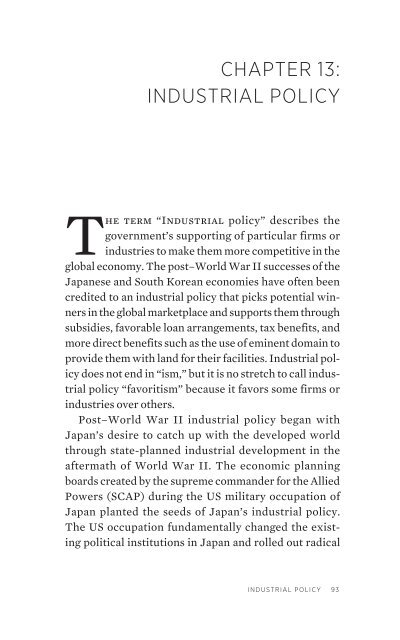url?sa=t&source=web&cd=1&ved=0CCYQFjAA&url=http://mercatus.org/sites/default/files/Holcombe_Cronyism_web
url?sa=t&source=web&cd=1&ved=0CCYQFjAA&url=http://mercatus.org/sites/default/files/Holcombe_Cronyism_web
url?sa=t&source=web&cd=1&ved=0CCYQFjAA&url=http://mercatus.org/sites/default/files/Holcombe_Cronyism_web
Create successful ePaper yourself
Turn your PDF publications into a flip-book with our unique Google optimized e-Paper software.
CHAPTER 13:<br />
INDUSTRIAL POLICY<br />
The term “Industrial policy” describes the<br />
government’s supporting of particular firms or<br />
industries to make them more competitive in the<br />
global economy. The post–World War II successes of the<br />
Japanese and South Korean economies have often been<br />
credited to an industrial policy that picks potential winners<br />
in the global marketplace and supports them through<br />
subsidies, favorable loan arrangements, tax benefits, and<br />
more direct benefits such as the use of eminent domain to<br />
provide them with land for their facilities. Industrial policy<br />
does not end in “ism,” but it is no stretch to call industrial<br />
policy “favoritism” because it favors some firms or<br />
industries over others.<br />
Post–World War II industrial policy began with<br />
Japan’s desire to catch up with the developed world<br />
through state-planned industrial development in the<br />
aftermath of World War II. The economic planning<br />
boards created by the supreme commander for the Allied<br />
Powers (SCAP) during the US military occupation of<br />
Japan planted the seeds of Japan’s industrial policy.<br />
The US occupation fundamentally changed the existing<br />
political institutions in Japan and rolled out radical<br />
INDUSTRIAL POLICY 93


